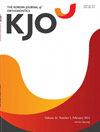读者的论坛。
IF 1.9
3区 医学
Q1 Dentistry
引用次数: 0
摘要
本文章由计算机程序翻译,如有差异,请以英文原文为准。
READER'S FORUM.
A1. When taking CT, the patient is in the natural head position. The patient’s head is centered while looking straight ahead. It is most important that the patient’s maxillary and mandibular arches are in the most maximum contacted intercuspal position. Because the most maximum contacted intercuspal position is a stable position. Postoperative CT also adopts such a occlusal relationship, which is convenient for comparison before and after surgery.
求助全文
通过发布文献求助,成功后即可免费获取论文全文。
去求助
来源期刊

Korean Journal of Orthodontics
Dentistry-Orthodontics
CiteScore
2.60
自引率
10.50%
发文量
48
审稿时长
3 months
期刊介绍:
The Korean Journal of Orthodontics (KJO) is an international, open access, peer reviewed journal published in January, March, May, July, September, and November each year. It was first launched in 1970 and, as the official scientific publication of Korean Association of Orthodontists, KJO aims to publish high quality clinical and scientific original research papers in all areas related to orthodontics and dentofacial orthopedics. Specifically, its interest focuses on evidence-based investigations of contemporary diagnostic procedures and treatment techniques, expanding to significant clinical reports of diverse treatment approaches.
The scope of KJO covers all areas of orthodontics and dentofacial orthopedics including successful diagnostic procedures and treatment planning, growth and development of the face and its clinical implications, appliance designs, biomechanics, TMJ disorders and adult treatment. Specifically, its latest interest focuses on skeletal anchorage devices, orthodontic appliance and biomaterials, 3 dimensional imaging techniques utilized for dentofacial diagnosis and treatment planning, and orthognathic surgery to correct skeletal disharmony in association of orthodontic treatment.
 求助内容:
求助内容: 应助结果提醒方式:
应助结果提醒方式:


